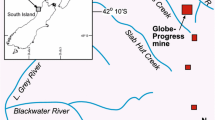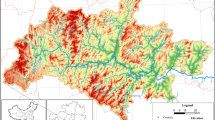Abstract
Antimony (Sb) is strongly concentrated into hydrothermal mineral deposits, commonly with gold, in metasedimentary sequences around the Pacific Rim. These deposits represent potential point sources for Sb in the downstream environment, particularly when mines are developed. This study documents the magnitude and scale of Sb mobility near some mineral deposits in Australia and New Zealand. Two examples of New Zealand historic mining areas demonstrate that natural groundwater dissolution of Sb from mineral deposits dominates the Sb load in drainage waters, with Sb concentrations between 3 and 24 μg/L in major streams. Mine-related discharges can exceed 200 μg/L Sb, but volumes are small. Sb flux in principal stream waters is ca 1–14 mg/s, compared to mine tunnel fluxes of ca 0.001 mg/s. Dissolved Sb is strongly attenuated near some mine tunnels by adsorption on to iron oxyhydroxide precipitates. Similar Sb mobilisation and attenuation processes are occurring downstream of the historic/active Hillgrove antimony–gold mine of New South Wales, Australia, but historic discharges of Sb-bearing debris has resulted in elevated Sb levels in stream sediments (ca 10–100+ mg/kg) and riparian plants (up to 100 mg/kg) for ca 300 km downstream. Dissolution of Sb from these sediments ensures that river waters have elevated Sb (ca 10–1,000 μg/L) over that distance. Total Sb flux reaching the Pacific Ocean from the Hillgrove area is ca 8 tonnes/year, of which 7 tonnes/year is particulate and 1 tonne/year is dissolved.






Similar content being viewed by others
References
Adriano DC (1986) Trace elements in the terrestrial environment. Springer, Berlin Heidelberg New York
Ainsworth N, Cooke JA, Johnson MS (1990) Distribution of antimony in contaminated grassland: I: vegetation and soils. Environ Pollut 65:65–77
Ashley PM, Craw D (2004) Structural controls on hydrothermal alteration and gold–antimony mineralisation in the Hillgrove area, NSW, Australia. Mineral Deposita 39:223–239
Ashley PM, Craw D, Graham BP, Chappell DA (2003) Environmental mobility of antimony around mesothermal stibnite deposits, New South Wales, Australia and southern New Zealand. J Geochem Explor 77:1–14
Ashley PM, Graham BP (2001) Heavy metal loadings of streams in the Macleay River catchment. Geological Survey of New South Wales Open File Report GS2001/303
Barin I (1989) Thermochemical data of pure substances. Part II. VCH Verlagsgesellschaft, Weinheim
Christie AB, Brathwaite RL (2003) Hydrothermal alteration in metasedimentary rock-hosted orogenic gold deposits, Reefton goldfield, South Island, New Zealand. Mineral Deposita 38:87–107
Craw D, Wilson NJ, Ashley PM (2004) Geochemical controls on the environmental mobility of Sb and As at mesothermal antimony and gold deposits. Trans Inst Mining Metall (Appl Earth Sci) 113:B3–B10
Cutter GA, Cutter LS, Featherstone AM, Lohrenz SE (2001) Antimony and arsenic biogeochemistry in the western Atlantic Ocean. Deep Sea Res II 48:2895–2915
Filella M, Belzile N, Chen Y-W (2002) Antimony in the environment: a review focused on natural waters. I. Occurrence. Earth Sci Rev 57:125–176
Giggenbach WF, Sheppard DS, Robinson BW, Stewart MK, Lyon GL (1994) Geochemical structure and position of the Waiotapu Geothermal Field, New Zealand. Geothermics 23:599–644
Goldfarb RJ, Groves DI, Gardoll S (2001) Orogenic gold and geologic time: a global synthesis. Ore Geol Rev 18:1–75
Johnston MR (1993) Gold in a tin dish: the search for gold in Marlborough and Eastern Nelson. Nikau Press, Nelson
Jones B, Renaut RW, Rosen MR (2001) Biogenicity of gold- and silver-bearing siliceous sinters forming in hot (75°C) anaerobic spring-waters of Champagne Pool, Waiotapu, North Island, New Zealand. J Geol Soc Lond 158:895–911
Mok WM, Wai CM (1990) Distribution and mobilization of arsenic and antimony species in the Coeur d’Alene River, Idaho. Environ Sci Technol 24:102–108
Mori C, Orsini A, Migon C (1999) Impact of arsenic and antimony contamination on benthic invertebrates in a minor Corsican river. Hydrobiologia 392:73–80
Neal C, Davies H (2003) Water quality fluxes for eastern UK rivers entering the North Sea: a summary of information from the Land Ocean Interaction Study (LOIS). Sci Total Environ 314–316:821–882
Nesbitt BE, Muelenbachs K, Murowchick JB (1989) Genetic implications of stable isotope characteristics of mesothermal Au deposits and related Sb and Hg deposits in the Canadian Cordillera. Econ Geol 84:1489–1506
NWQMS (National Water Quality Management Strategy) (2000) Australian and New Zealand guidelines for fresh and marine water quality, Vols. 1, 2. Australia and New Zealand Environment and Conservation Council and Agriculture and Resource Management Council of Australia and New Zealand, Canberra
Pirajno F (1979) Geology, geochemistry, and mineralisation of the Endeavour Inlet antimony–gold prospect, Marlborough Sounds, New Zealand. NZ J Geol Geophys 22:227–236
Shotyk W, Krachler M, Chen B (2005) Anthropogenic impacts on the biogeochemistry and cycling of antimony. In: Sigel A, Sigel H, Sigel RKO (eds) Biogeochemistry, availability and transport of metals in the enviromment, metal ions in biological systems. Vol. 44. M. Dekker, New York, pp 177–203
Tessier A, Campbell PCG, Bisson M (1979) Sequential extraction procedure for the speciation of particulate heavy metals. Anal Chem 51:844–851
Tighe M, Ashley P, Lockwood P, Wilson S (2005) Soil, water and pasture enrichment of antimony and arsenic within a coastal floodplain system. Sci Total Environ 347:175–186
Vink B (1996) Stability relations of antimony and arsenic compounds in the light of revised and extended E H–pH diagrams. Chem Geol 130:21–30
WHO (World Health Organization) (1996) Guidelines for drinking-water quality, Vol 2: Health criteria and other supporting information, 2nd edn. Geneva, World Health Organisation: pp 973
Wilson NJ, Craw D, Hunter KA (2004a) Antimony distribution and environmental mobility at an historic antimony smelter site, New Zealand. Environ Pollut 129:257–266
Wilson NJ, Craw D, Hunter KA (2004b) Contributions of discharges from a historic antimony mine to metalloid content of river waters, Marlborough, New Zealand. J Geochem Explor 84:127–139
Acknowledgments
This research was supported financially by the NZ Foundation for Research, Science and Technology, University of Otago, University of New England, NSW Department of Mineral Resources, and Mid-North Coast Catchment Management Committee. We are grateful to Oceana Gold (NZ) Ltd for providing access to analytical and flow rate data for the Globe Hill area, and to NZ Department of Conservation for permission to sample historic mine sites. Discussions with Ben Graham and Peter Lockwood helped us to develop the ideas and results contained herein. Stimulating dialogue at the First International Workshop on Antimony in the Environment at Heidelberg, prompted preparation of this paper.
Author information
Authors and Affiliations
Corresponding author
Rights and permissions
About this article
Cite this article
Ashley, P.M., Craw, D., Tighe, M.K. et al. Magnitudes, spatial scales and processes of environmental antimony mobility from orogenic gold–antimony mineral deposits, Australasia. Environ Geol 51, 499–507 (2006). https://doi.org/10.1007/s00254-006-0346-6
Accepted:
Published:
Issue Date:
DOI: https://doi.org/10.1007/s00254-006-0346-6




